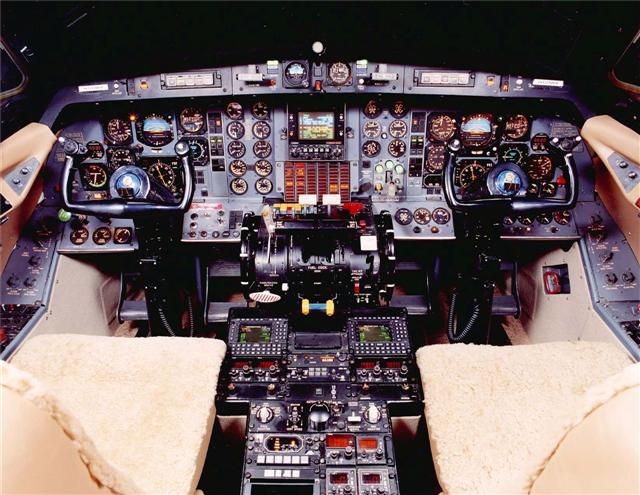


Aircraft Description
Background/History
The Gulfstream II was announced by Grumman in 1965 as a turbofan-powered replacement for the Gulfstream I turboprop executive transport. The transformation could hardly have been more thorough: the G-II was equipped with an entirely new swept wing, and the pair of Rolls-Royce Spey turbofans were mounted on pylons just ahead of an all-new T-tail. In 1979, the G-II was succeeded by the Gulfstream III. The new model featured, among other improvements, a new wing with winglets whose improved aerodynamic properties resulted in significantly decreased fuel burn and greater range. For the operators of the 258 G-II models already in service, Gulfstream offered the Aircraft Service Change No. 300 retrofit: This package involved replacing the G-II wing with the new G-III wing, and included strengthening of the fuselage at the wing/fuselage junction, as well as an assortment of other modifications, such as replacement of the G-II’s steel brakes with carbon units and engine hush kits. The modified aircraft, designated the Gulfstream IIB, offers an increase in range of about 900 nm. The Gulfstream IIB was granted certification by the FAA in September 1981. Approximately 42 aircraft were retrofitted to the GIIB configuration.
Power
The Gulfstream G-IIB is powered by a pair of Rolls-Royce Spey Mk511-8 turbofans rated at 11,400 lbs. of thrust each. Inspection interval on the engines is 8,000 hours.
Avionics
A variety of avionics equipment can be found in Gulfstream IIB’s, although most G-IIB panels are built around the Honeywell SPZ-800 system, with the Sperry SP 50G autopilot and dual Honeywell Laser INS. A typical radio installation will include dual Collins VHF-20A comms, VIR-30 navs, dual DME, dual ADF, dual transponders, color weather radar, flitefone, and HF comms for overseas operations.
Design Features
The Gulfstream G-IIB is configured as a cantilever low swept-wing monoplane with cantilever swept T-tail. The landing gear is of the retractable tricycle type with dual wheels on each unit (the original G-II main gear is retained for installation on the new wing under the ASC 300 package.) The G-IIB features the wing of the G-III, complete with its drag-reducing Whitcomb winglets. The fuel system utilizes internal wing tanks only, and is essentially the same as the G-III fuel system, with the cockpit instrumentation modified accordingly.
Accomodations
The Gulfstream G-IIB has been completed in a variety of configurations, but typical executive cabins accommodate 10 to 14 passengers in combinations of club seating, side divan, and individual passenger seats. The aircraft is commonly outfitted with a large working galley, entertainment center, and full-sized aft lavatory. The standup cabins of the Gulfstream line have long been some of the largest available in corporate aircraft. The G-IIB cabin width is 7.3 ft., cabin height is 6.1ft. and length is 33.9ft.
| General | G-IIB, G-1159B | |||
|---|---|---|---|---|
| Category | Jet < 20,000 lbs. | |||
| Years Aircraft Manufactured | 1968 – 1979, (retrofit) | |||
| Serial Number Range | 004 – 257 (various) | |||
| Retail High Price | $2,500,000.00 / 1,961,750.00€ | |||
| Retail Low Price | $2,500,000.00 / 1,961,750.00€ | |||
| Characteristics | G-IIB, G-1159B | |||
| Seating | 2 + 10/19 | |||
| Wing Loading | 74.5 | |||
| Power Loading | 3.0 | |||
| Noise(EPNdB): Takeoff/Sideline/Approach | N/A | |||
| External Dimensions (ft) | G-IIB, G-1159B | |||
| External Length | 79.9 | |||
| External Height | 24.5 | |||
| External Span | 72.8 | |||
| Internal Dimensions (ft) | G-IIB, G-1159B | |||
| Internal Length (Overall/Net Height) | 33.9 | |||
| Internal Height | 6.1 | |||
| Internal Width (Max/Floor) | 7.3 | |||
| Baggage | G-IIB, G-1159B | |||
| External: Cu.Ft./Lb. | N/A | |||
| External: Cu.Ft./Lb. | N/A | |||
| Power | G-IIB, G-1159B | |||
| Engines | 2 RR Spey Mk 511-8 | |||
| Output (lbs ea.)/Flat Rating | 11,400 | |||
| Inspection Interval | 8,000t | |||
| Data based on latest manufactured year | ||||



